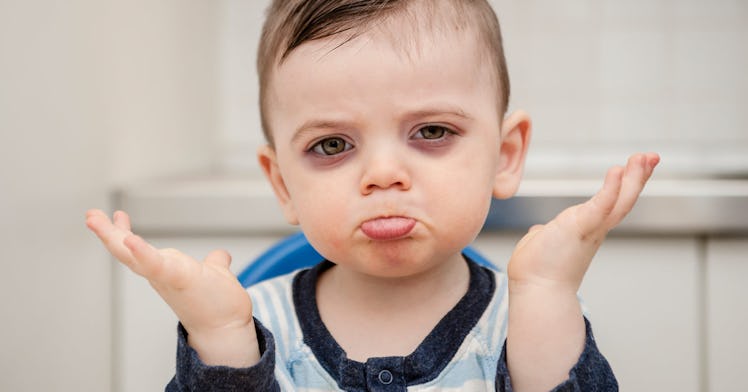What’s Up With The Dark Circles Under Your Kid’s Eyes?
Pediatricians explain how kids get dark circles and bags under their eyes, and why it's rarely cause for concern.

If you’re the parent of a toddler, dark circles under your kid’s eyes may seem so common that they barely register. But swipe through some iPhone photos with your single friends, and they’ll tell you the truth: Your child looks like a middle-aged accountant knee-deep in tax season. Needless to say, dark circles under kids’ eyes can be a bit disconcerting. But most toddlers who manifest puffy eyes, red eyes, or even eye bags a la Michael Caine aren’t actually worried or sleep-deprived (as you yourself most likely are). These dark circles under your kid’s eyes are more likely the result of infant allergies or a genetic predisposition to what scientists and pretentious makeup salespeople call “periorbital dark circles.” They’re not, as some might suspect, the result of stress placed on a financial planner in a bear market.
“Most often dark circles are not due to lack of sleep or poor health,” says Alison Mitzner, M.D., a New York-based pediatrician. Mitzner notes that genetics and seasonal allergies are almost always to blame for bags under kids’ eyes. Nasal congestion from allergies restricts blood flow, making the veins under the eyes expand and darken. This results in dark circles under the eyes, which may be more visible in children with light skin. And this is the same reason why a kid’s eyes can look dark and puffy when they’re sick.
In essence, dark circles and puffy bags form under kids’ eyes for the same physiological reasons as they do in adults. The skin around the eye is thinner and more transparent than other parts of the face, so it can’t fully cover up the soft tissue and veins that surround the eye. For some people, this results in dark circles, even as toddlers.
Puffy bags and dark circles under kids’ eyes are sometimes made worse by fluid retention, which is why they are more visible after a salty meal. Most obviously, lack of sleep causes blood vessels under the eyes to dilate while upping fluid retention. This results in even puffier, darker eyes. Those predisposed to dark circles can coat their under-eye area with makeup, but they can’t treat the problem at its source, research shows.
When children are getting enough sleep and still have dark circles under their eyes, it’s probably worth consulting a pediatrician. In any case, there is no shame in asking a doctor about a kid’s dark eye circles just to be safe, even if they’re just going to hold up a mirror.
“Dark circles and bags under the eyes are usually no cause for alarm,” says Andrew J. Bernstein, M.D., a professor of clinical pediatrics at Northwestern University. “They can point to allergies, ‘allergic shiners,’ a lack of sleep, or, most commonly, they can just be a hereditary coloration or shape of the eyes.”
“Your pediatrician can work with you to determine the cause to ensure there are no other health issues that, although rare, may be the cause,” Mitzner says. After all, you don’t want to lose any more sleep over your kid’s eye bags and make your own bigger in the process.
4 Reasons for Dark Circles Under Kids’ Eyes
- Genetic predisposition: Sorry, folks, but kids with bags under their eyes are often predisposed to periorbital dark circles. It will be something they deal with for life.
- Infant allergies: Allergies can restrict blood flow, making the veins under the eye expand and darken.
- Lack of sleep: Same as allergies, lack of sleep restricts blood flow. Less sleep, more bags.
- Fluid retention: Did your kid eat a big ol’ salty meal? See how it makes those bags pop?
This article was originally published on